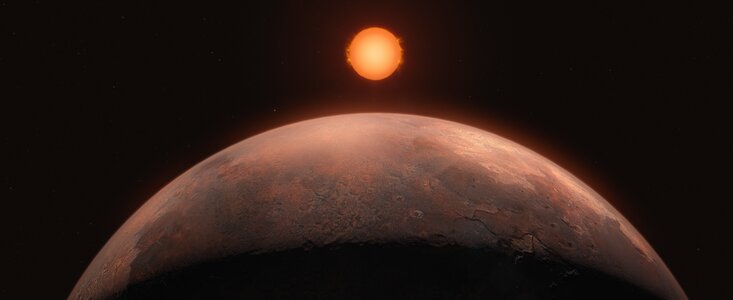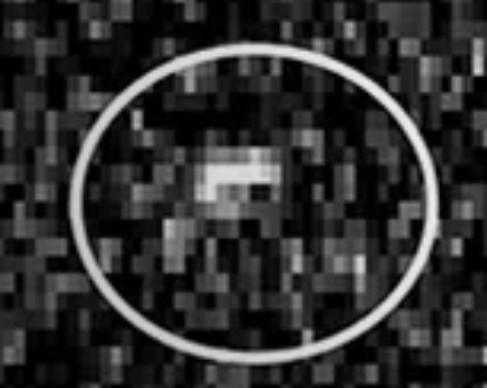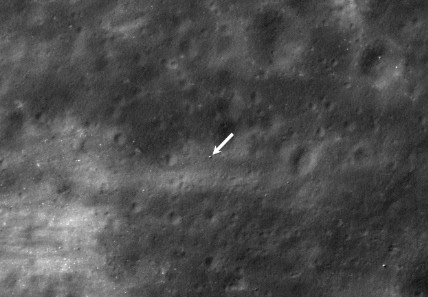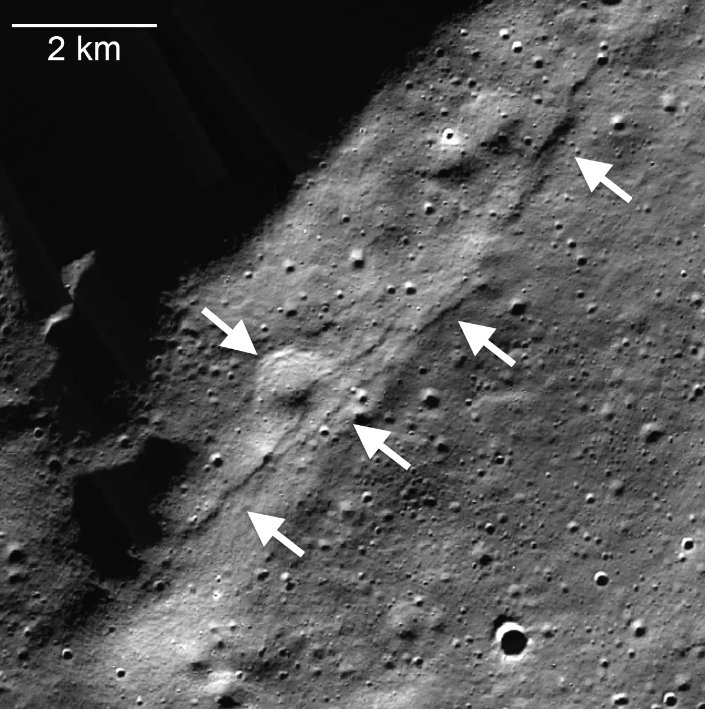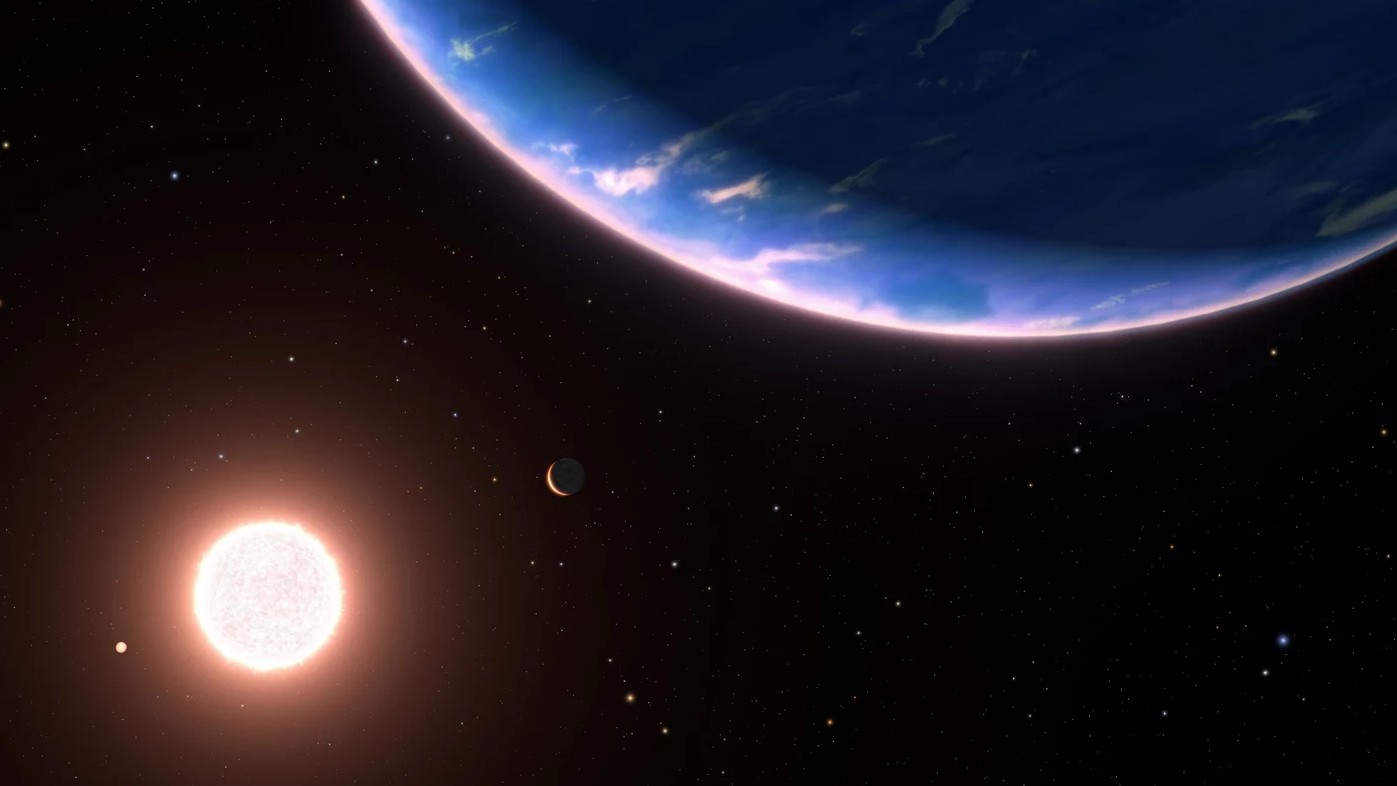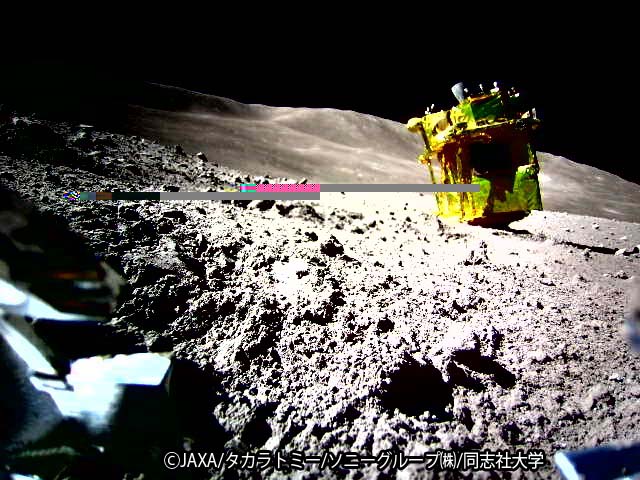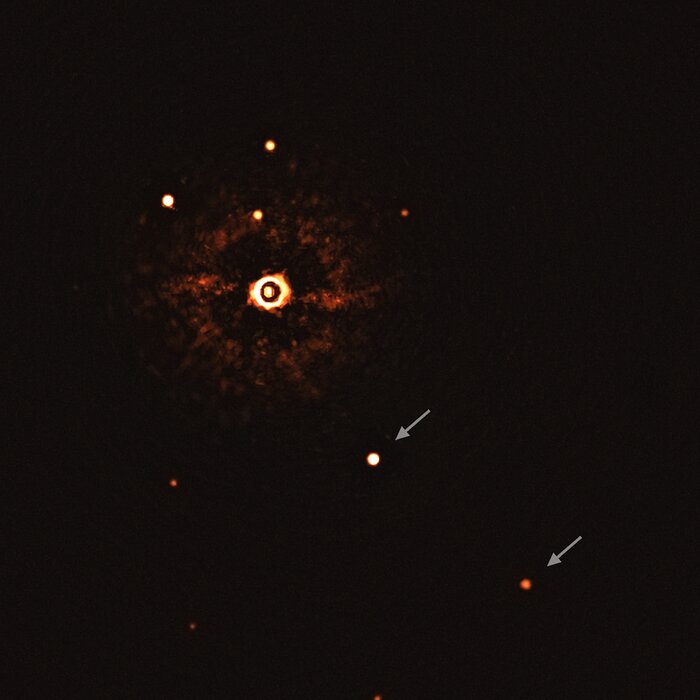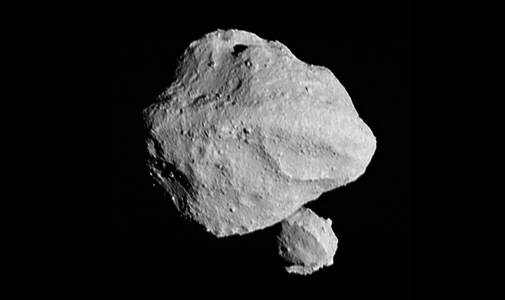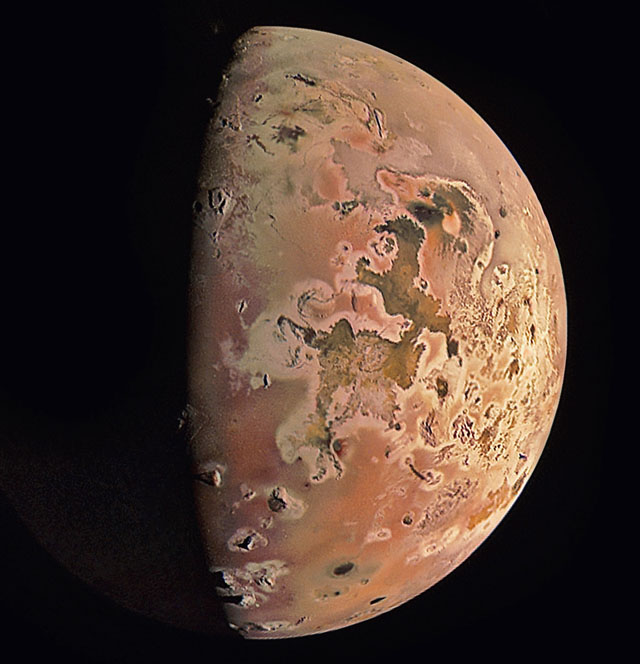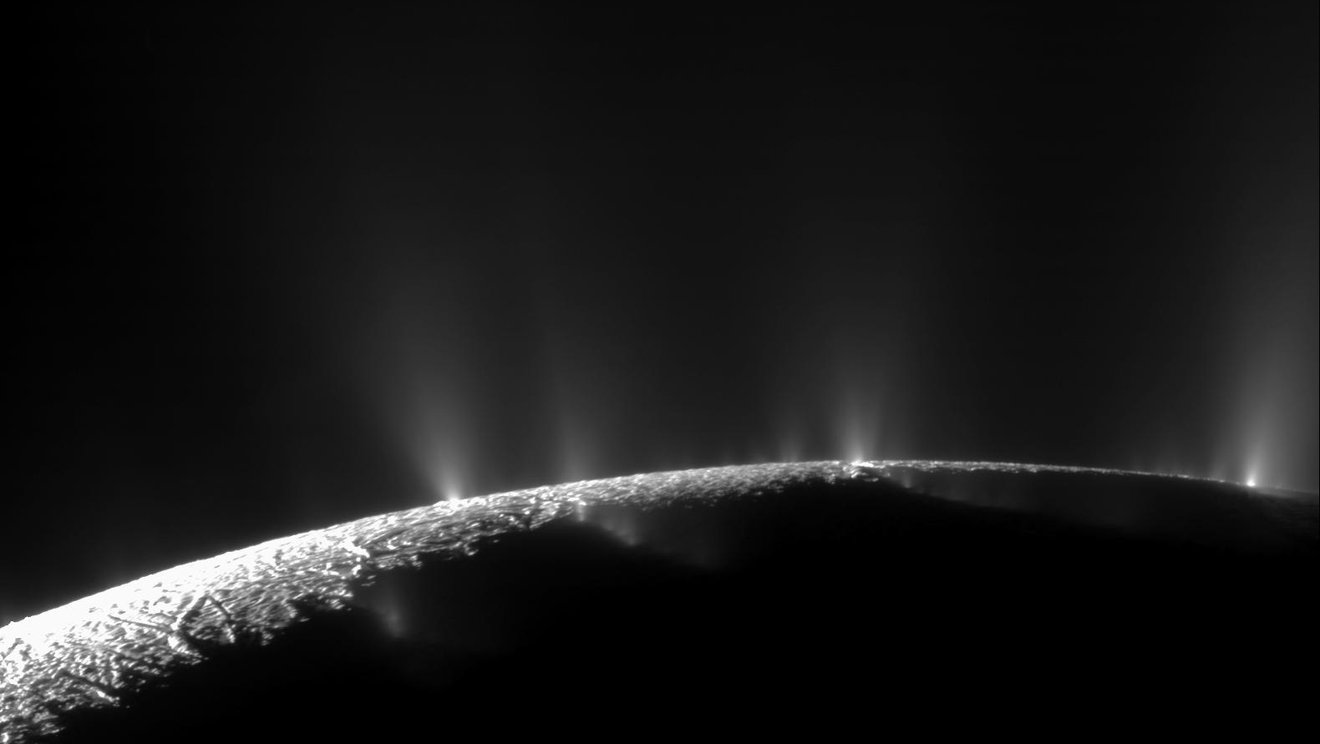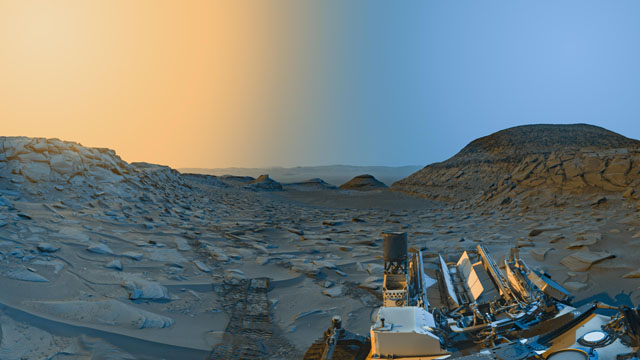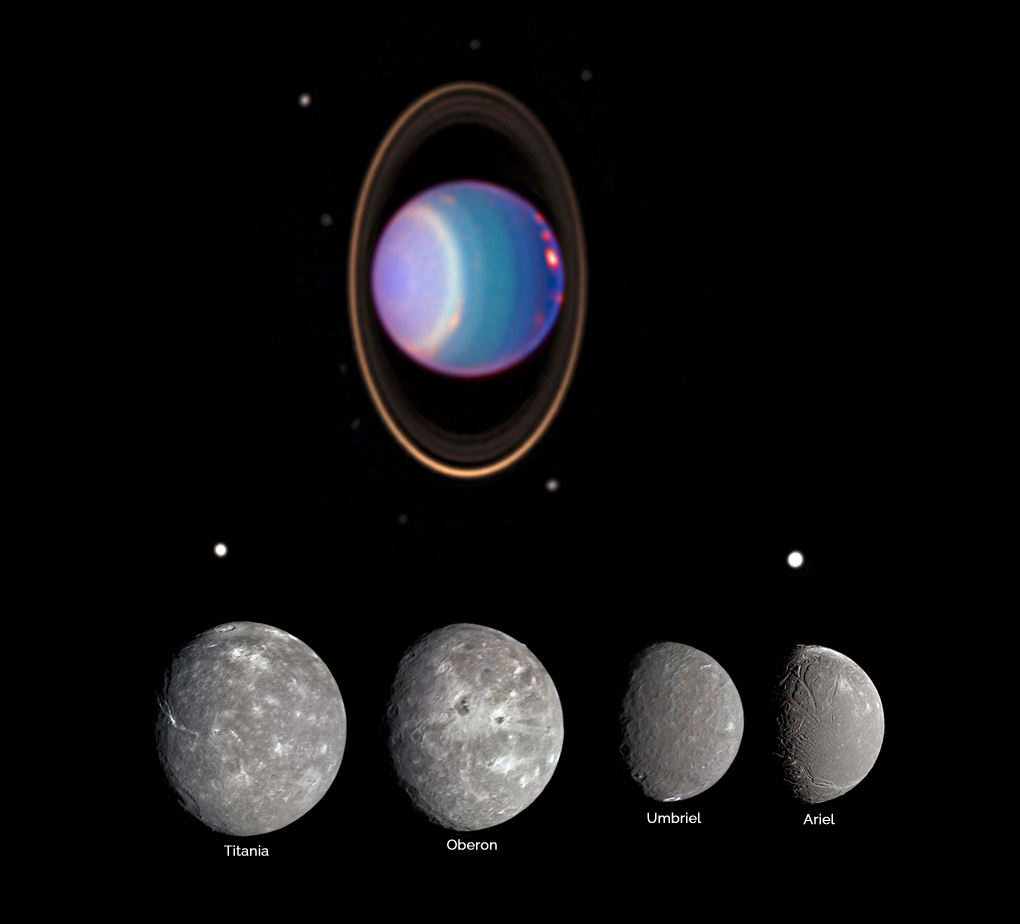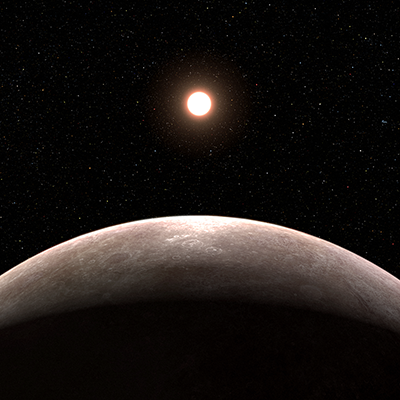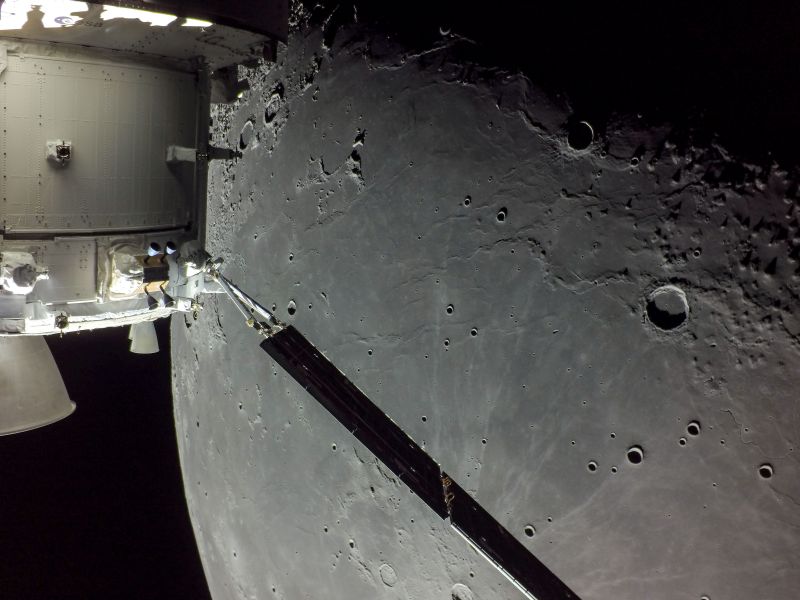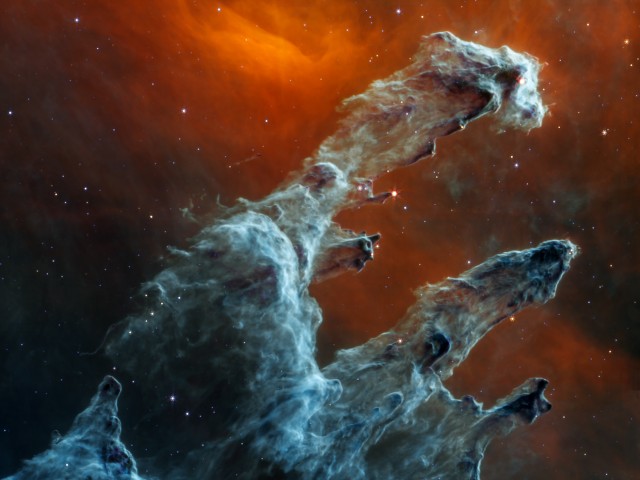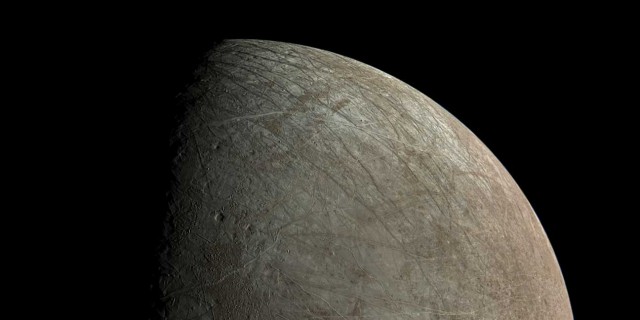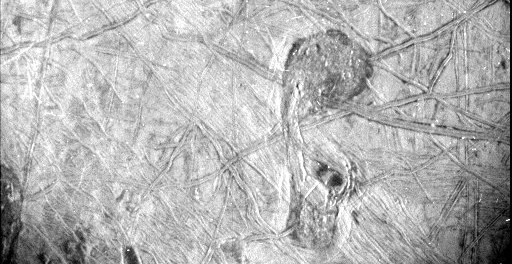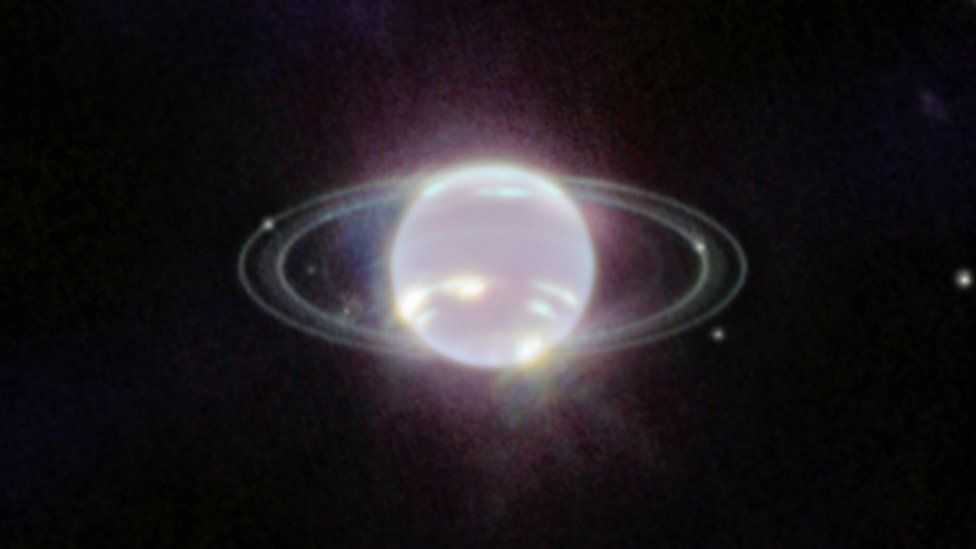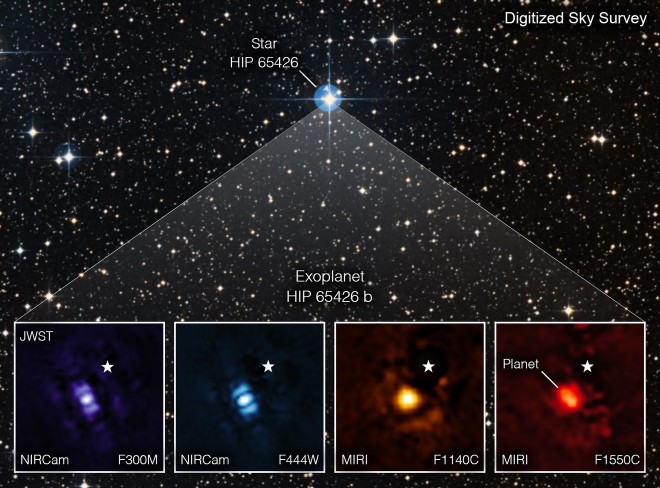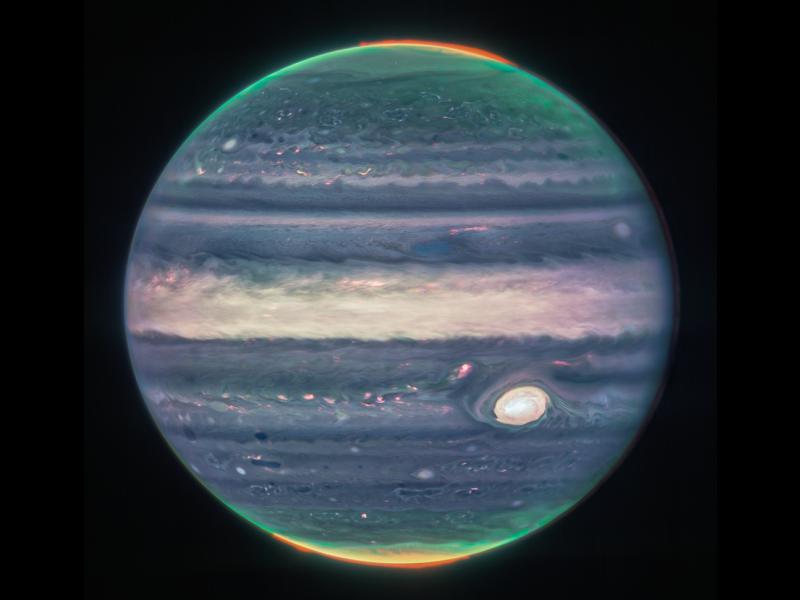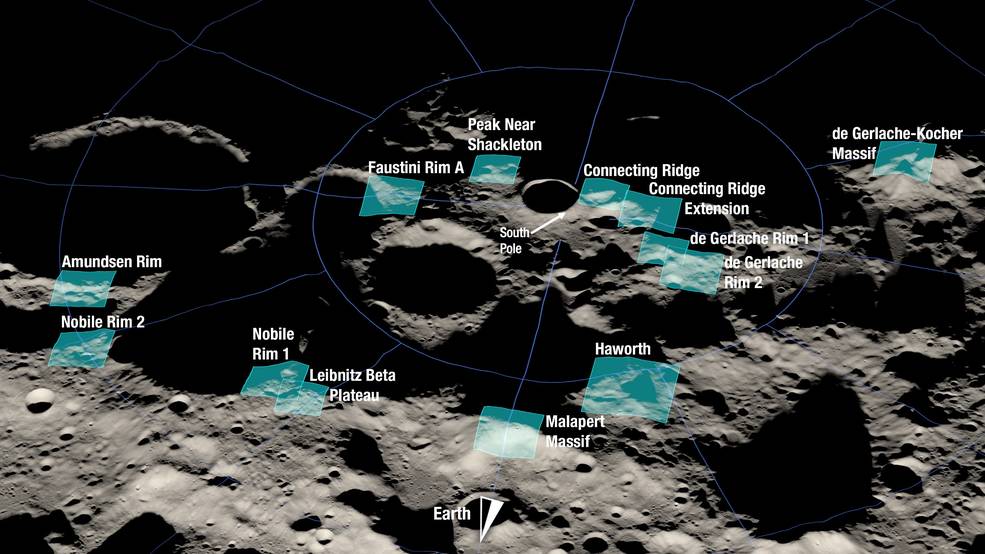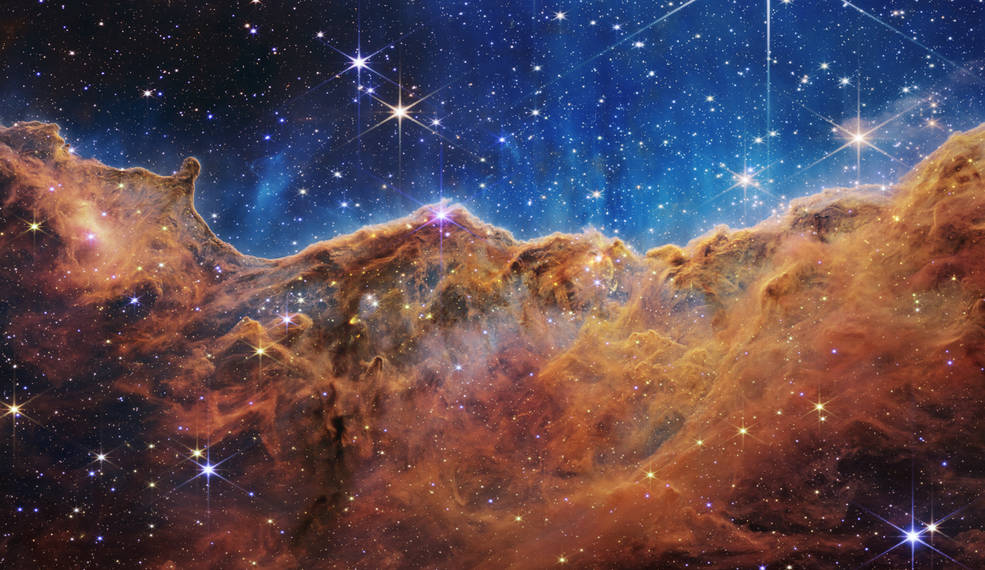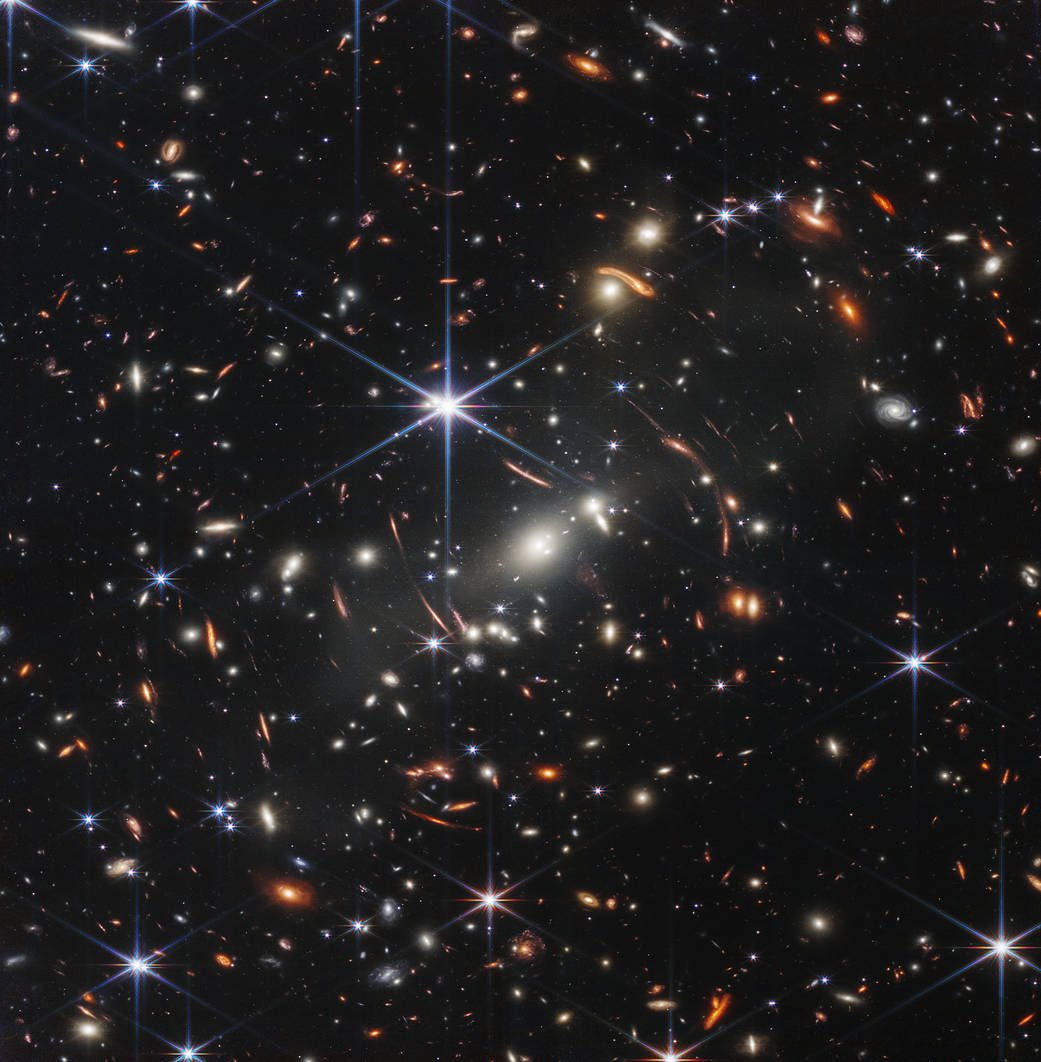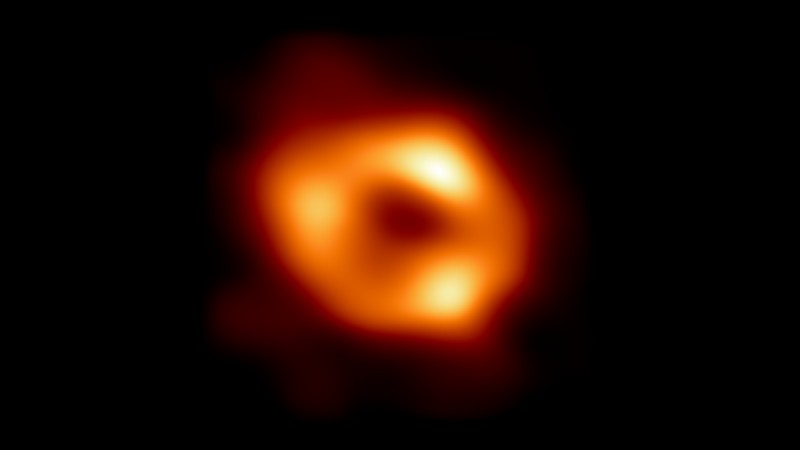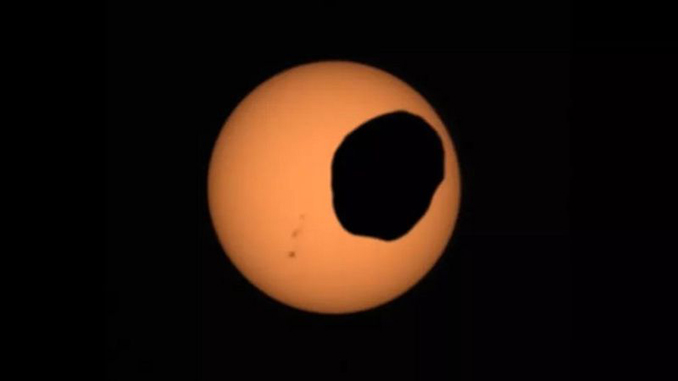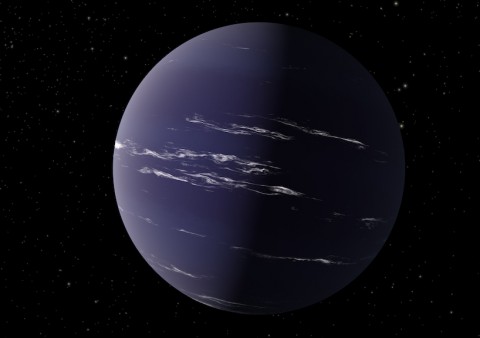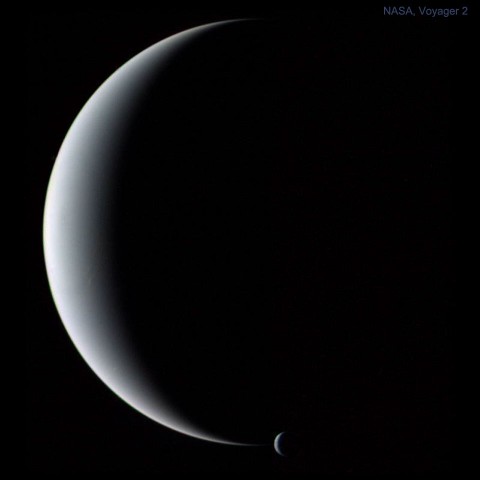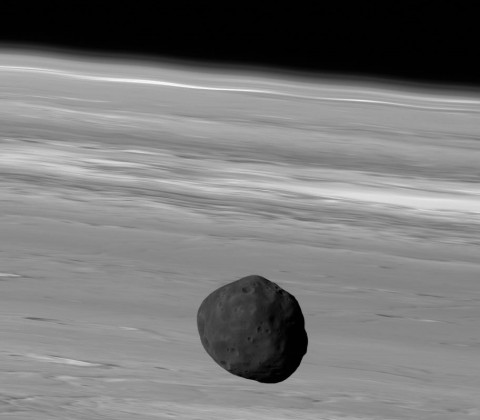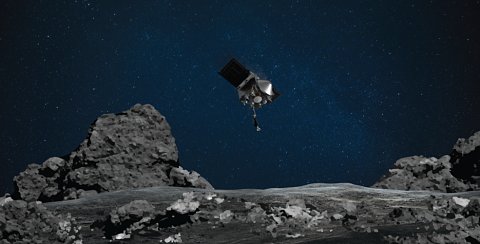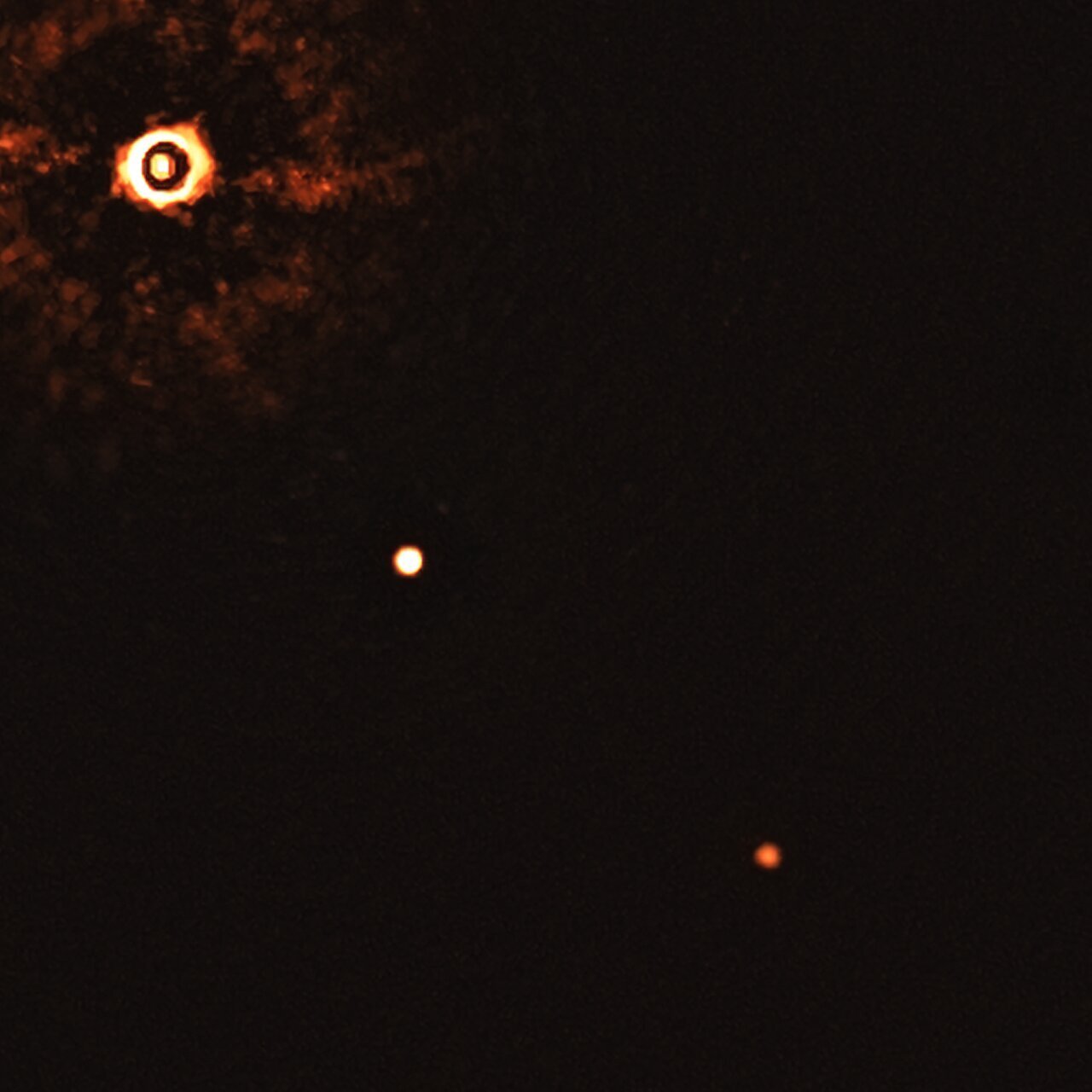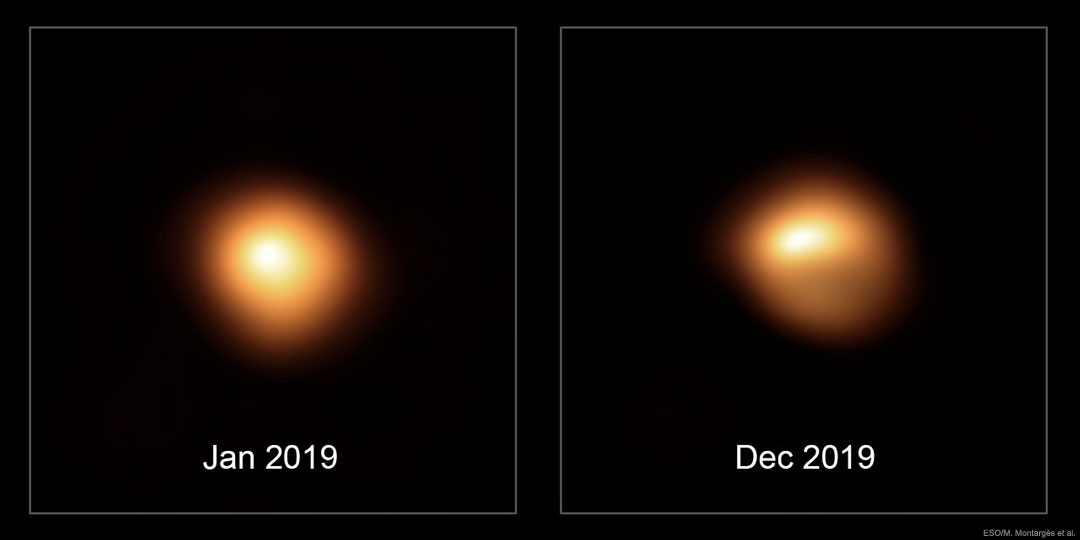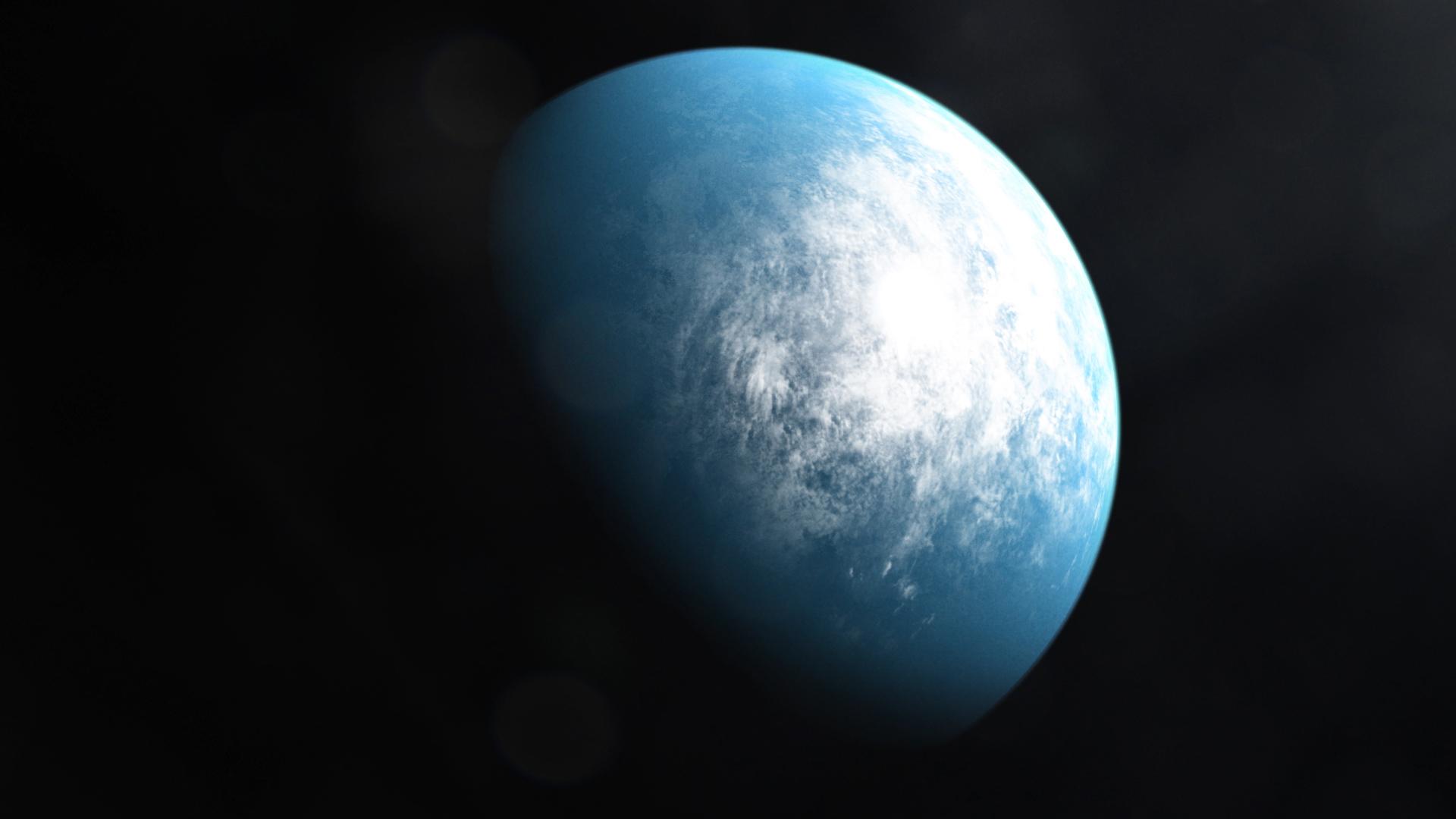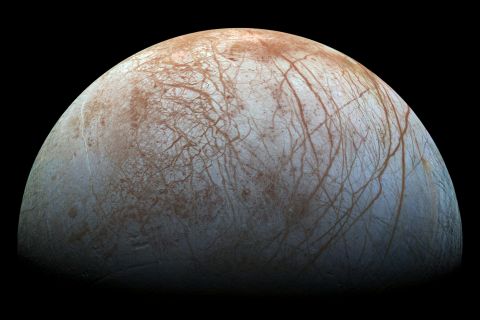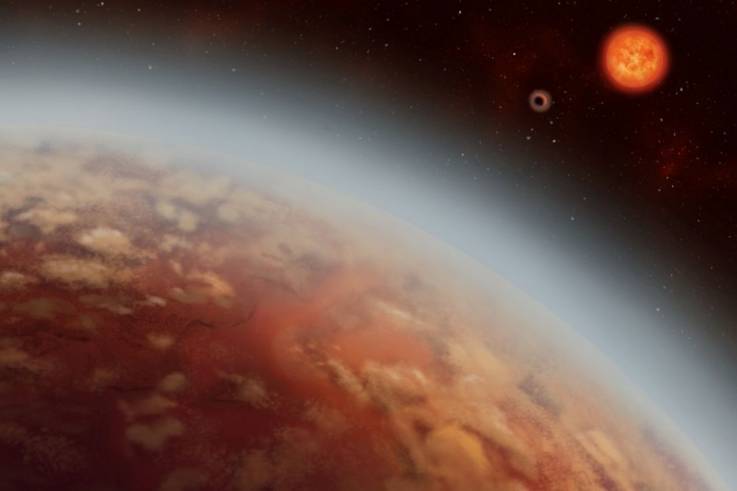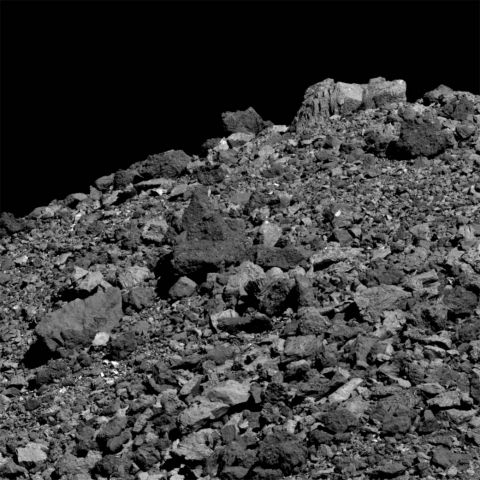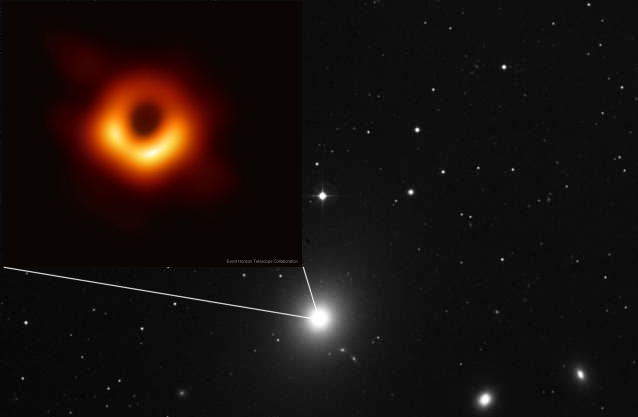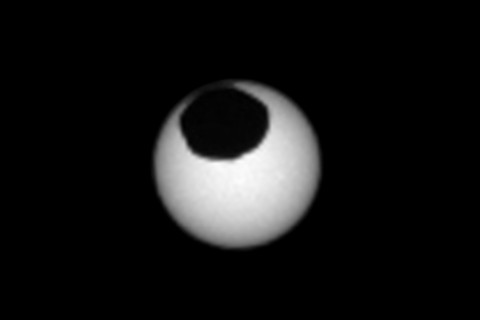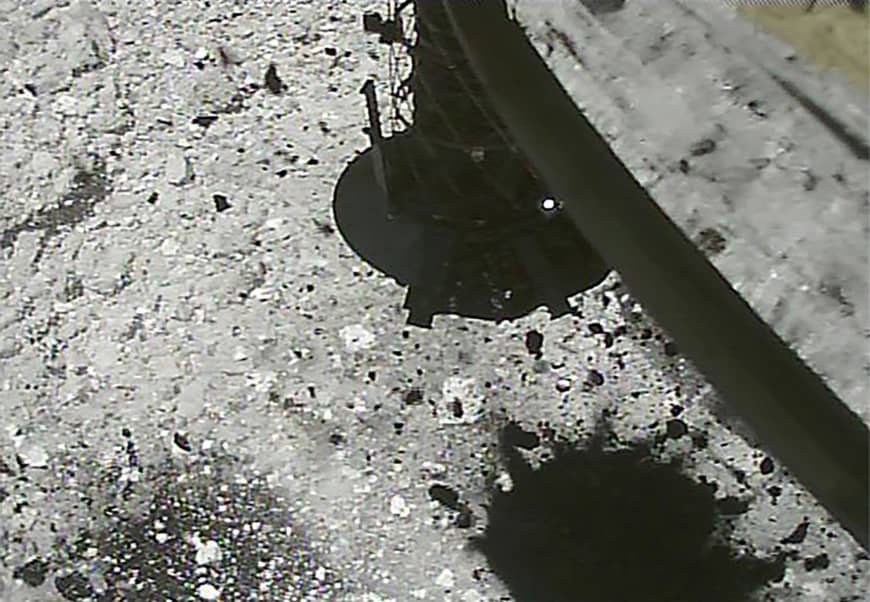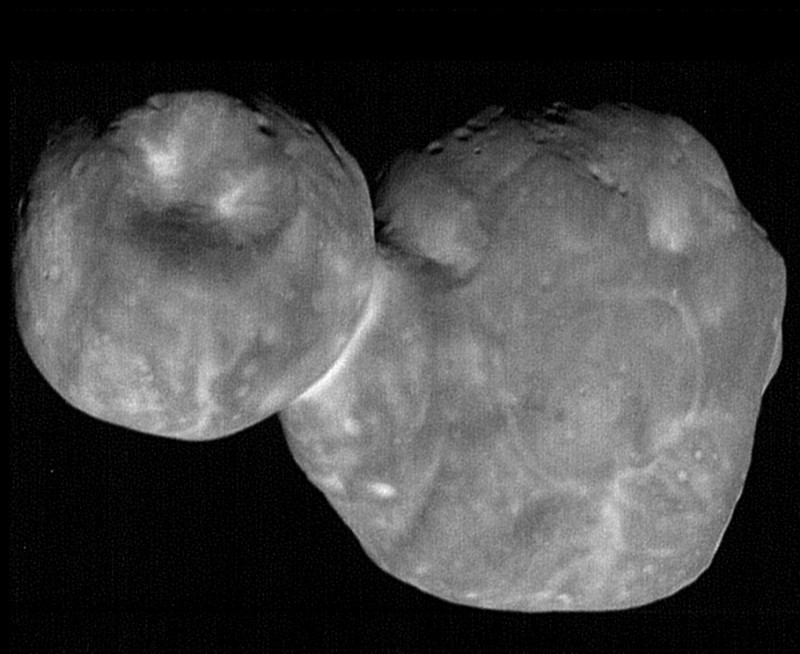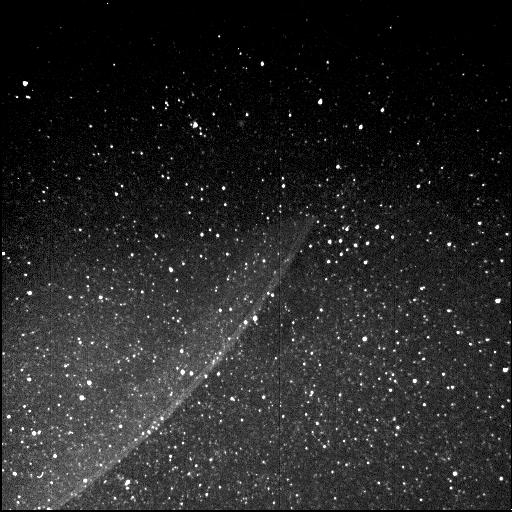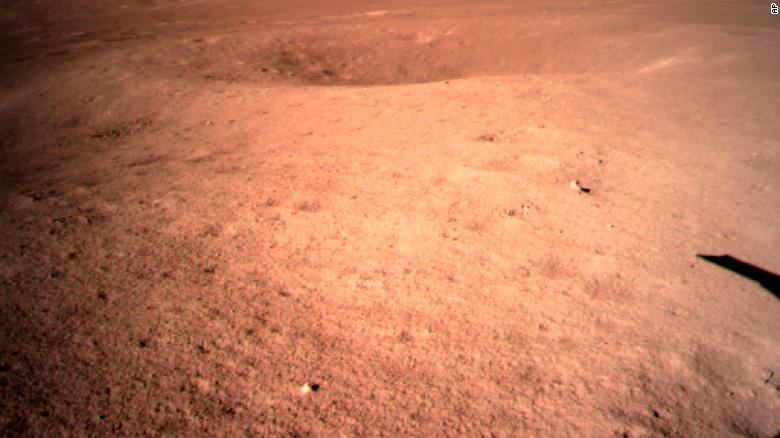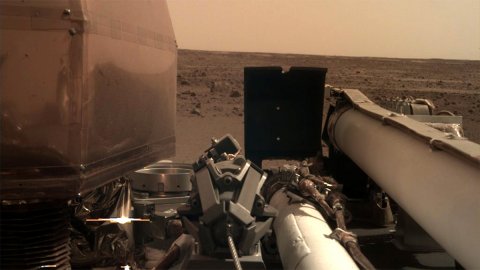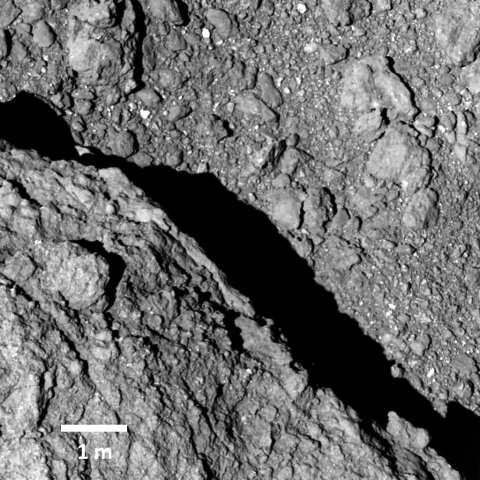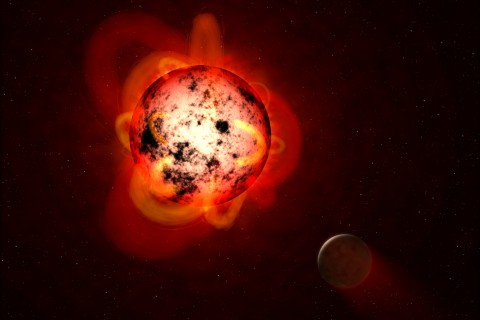Breaking News Backlog
Close NEO Approach
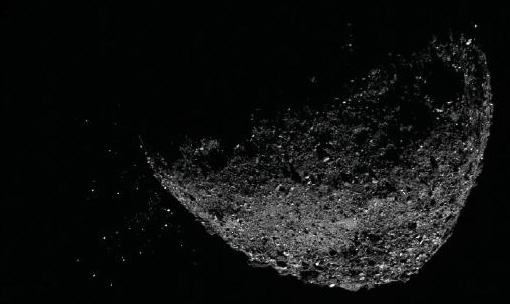
Image credit: NASA/Goddard/University of Arizona/Lockheed Martin
2024-10-07 solar system
Just for info, no danger posed. This year, NEO asteroid 2024 TR4, estimated 14 meters across flew past Earth on October 7 at 01:07 UTC at a distance of approximately 112,000 km at a speed of 15 km/sec. The distance equals to 0.3 lunar distances which is a very close encounter (the image shows asteroid Bennu). Link to source 🔗
Planet around Barnard's Star
Image credit: ESO/M. Kornmesser
2024-10-05 Exoplanets
High proper motion, single star, Barnard's Star is only about 6 light-years away in Ophiuchus. Using ESO's VLT astronomers have detected a rocky planet orbiting at a distance 20 times closer than Mercury is to the sun resulting in a short 3.15 days orbit and a scorching 125°C surface temperature. Link to source 🔗
Asteroid Apophis
Image credit: NASA/JPL
2024-03-15 solar system
According to NASA, on April 13, 2029, Apophis will pass less than 20,000 miles (32,000 kilometers) from Earth's surface, closer than the distance of geosynchronous satellites. Although previously dubbed the Doomsday Asteroid, about 340 meters wide Apophis does not pose any danger of impact during close approach in 2029 as it will be visible with the unaided eye. Link to source 🔗
SLIM Imaged by LROC
Image credit: NASA/Goddard/Arizona State University
2024-01-27 solar system
NASA’s Lunar Reconnaissance Orbiter captured this image of the JAXA SLIM lander on the Moon’s surface on Jan. 24, 2024. SLIM landed at -13.316° south latitude, +25.2510° east longitude, at an elevation of minus 912 meters. The image is 880 meters wide and lunar north is up. Link to source 🔗
Moonquakes near Lunar South Pole
Image credit: NASA/LRO/LROC/ASU/Smithsonian Institution
2024-01-27 solar system
Moon is shrinking and torn by tidal forces from Earth. Evidence for seismic activity has been detected near candidate regions for the Artemis III mission scheduled for a crewed lunar landing. Such quakes can produce ground shaking strong enough for faults to slide or for piling up new thrust faults. The LROC image shows a cluster of lobate scarps (left pointing arrows) near the lunar south pole. A thrust fault scarp cut across an approximately 1-km diameter degraded crater (right pointing arrow). Link to source 🔗
Hubble finds Water in an Exoplanet's Atmosphere
Image credit: NASA, ESA, Leah Hustak (STScI), Ralf Crawford (STScI)
2024-01-26 Exoplanets
Discovered in 2017, the Superterran planet GJ 9827 d is located some 97 light-years away in Pisces and may have a water-rich atmosphere in spite of being hotter than Venus because it orbits extremely close to it host star alongside two further known inner planets. Astronomers will further investigate with the help of the Hubble and James Webb space telescopes. Link to source 🔗
First Light from SLIM
Image credit: JAXA/タカラトミー/ソニーグループ(株)/ 同志社大学)
2024-01-25 solar system
JAXAs lunar lander SLIM has been photographed by its small rover, the Lunar Excursion Vehicle 2 (LEV-2). The soft landing about 55 meters east of target point was completed at 1.4m/sec surpassing specifications. Though the solar panels were supposed to face upwards after landing, on the photo SLIM is shown with its main engine facing upwards, but JAXA hopes it will gather sunlight and restore power until local sunset on Feb 1st. Analysis so far has also revealed that one of the two main engines was lost due to some abnormality at an altitude of 50 meters just before landing. Both exploration rover robots are in good working condition. SLIM landed on the moon at 15:20 on January 19 UTC. Link to source 🔗
Direct image of a multi-planet system
Image credit: ESO/Bohn et al.
2023-11-13 Exoplanets
Some 310 light-years away in the constellation of Musca two known planets the sun-like star, but only about 27 million years old TYC 8998-760-1 have been imaged directly. The inner planet b (21.6 jovian masses, 3 jovian radii, orbital period 4500 years) is 162 times the Earth-Sun distance, planet c (7.2 jovian masses, 1.1 jovian radii, orbital period 5700 years) is about 320 times away from its host star. Planet b could be a brown dwarf or a kind of failed star. Link to source 🔗
Lucy Imaged Asteroid Dinkinesh
Image credit: NASA / Goddard / SwRI / Johns Hopkins APL / NOIRLab
2023-11-09 Solar System
On November 1, 2023 at 16:54 UTC, NASA's Lucy spacecraft flew by its first of 11 asteroids on its travel agenda. The image was taken from a distance of 1630 km, 6 minutes past closest approach. Dinkinesh (152830) is a main belt asteroid about 760 meters across with an orbital period of 3.24 years. It has a 220 meters wide natural satellite which is a contact binary, the first detected orbiting a host asteroid. Link to source 🔗
Io from Juno
Image credit: NASA, JPL-Caltech, SwRI, MSSS
2023-10-23 Solar System
The innermost of the four Jovian satellites Io taken by NASA's Juno spacecraft from a distance of 12,000 kilometers in October 2023. About the size of Earth's moon and flexed by gravitational forces from Jupiter and the other larger moons Io is the most volcanically active place known in the solar system.
Phosphorus in Enceladus' Ice
Image credit: NASA/JPL/Space Science Institute
2023-06-15 Solar System
Phosphorus, a key chemical element for many biological processes, has been found locked inside salt-rich ice grains ejected into space from Enceladus. The image was captured by NASA's Cassini spacecraft as it flew past Enceladus and through the jets on Nov. 21, 2009. Link to source 🔗
Dusk and Dawn on Mars
Image credit: NASA/JPL-Caltech
2023-06-14 Solar System
Taken by NASA's Curiosity Mars rover with its monochrome navigation cameras on April 8, 2023, the panoramas were captured at 9:20 a.m. and 3:40 p.m. local Mars time, then merged together and colorized with blue representing the morning and yellow representing the afternoon side. Link to source 🔗
Farside of Moonlet Deimos
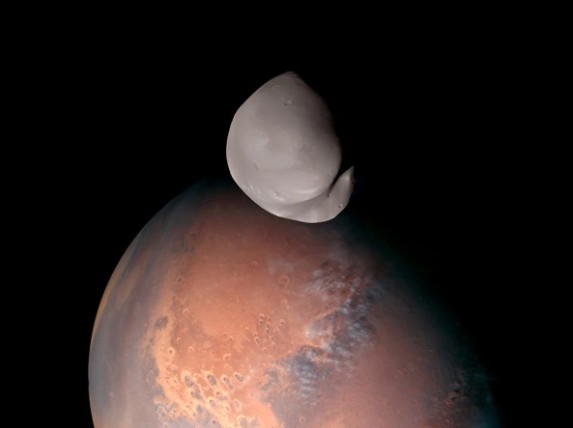
Image credit: UAE Space Agency, Emirates Mars Mission, Hope Spacecraft
2023-05-18 Solar System
On March 10, 2023 the United Arab Emirates’ Hope spacecraft flew by Deimos within 25 minutes at a distance of only 100km capturing 27 striking images, a world first of imaging Deimos’ farside that close. Link to source 🔗
Volcano-Covered Earth-Size World
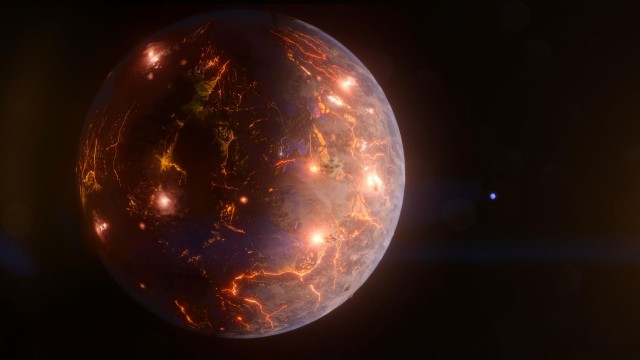
Image credit: NASA’s Goddard Space Flight Center/Chris Smith (KRBwyle)
2023-05-17 Exoplanets
An Earth-sized planet some 90ly away in Crater, LP 791-18 d, is most likely covered with volcanos which outburst as frequently as Jupiter's moon Io. The tidally locked planet is gravitationally torn by another, more massive planet in the same system. The eternal night side could sustain an atmosphere, which may allow water to condense. Link to source 🔗
Uranus' Large Moons
Image credit: NASA/JPL, Voyager II
2023-05-07 Solar System
Based on Voyager II data astronomers concluded that the largest four of Uranus' icy moons (27 known in total) may host layers of liquid water as assumed for Saturn's Enceladus and three Jovian moons, but much thinner, between 30 and 50 km deep. Link to source 🔗
Webb's First Exoplanet
Image credit: NASA, ESA, CSA, Leah Hustak (STScI)
2023-01-14 Exoplanets
Nothing exciting in terms of habitability, but the rocky planet LHS 475 b, 41 light-years away in Octans, is almost exactly the size of Earth. It is the first exoplanet confirmed by NASAs James Webb Space Telescope, JWST, which also revealed that the planet is a few hundred degrees warmer than Earth. An atmosphere hs not been confirmed but Webb is capable of characterizing the atmospheres of Earth-sized exoplanets. Link to source 🔗
Orion over the Ocean of Storms
Image credit: NASA, Artemis I
2022-12-08 Solar System
Taken during its return flyby, by the Orion spacecraft navigation camera on December 5, 2022, on the 20th day of the Artemis mission, this image shows the western region of Oceanus Procellarum. The large crater at the top center is 41km wide Marius. More known ray crater Kepler is at the center of the right edge. At its closest point, Orion flew within 130kms (80 miles) of the lunar surface. Link to source 🔗
Webb's Pillars of Creation
Image credit: NASA, ESA, CSA, STScI
2022-11-01 Universe
On August 14, 2022, NASAs James Webb Space Telescope imaged the "Pillars of Creation" located in the Eagle Nebula (M16 or NGC 6611) in mid-infrared, 6500 light-years away. The image is approximately 7 light-years across and has been processed by Joseph DePasquale and Alyssa Pagan, both STScI. Link to source 🔗
Enhanced Image of Europa
Image credit: NASA/JPL-Caltech/SwRI/MSSS. Image processing by Björn Jónsson CC BY-NC-SA 2.0
2022-10-07 Solar System
This view was created by processing an image NASA's spacecraft Juno captured during a close flyby over Jupiter's moon Europa on September 29, 2022 at a distance of 412 kilometers. Link to source 🔗
Highest Resolution Image of Europa
Image credit: NASA/JPL-Caltech/SwRI
2022-10-06 Solar System
Captured on September 29, 2022 at a distance of 412 kilometers this image's best resolution is at 256 meters per pixel, the highest ever of Jupiter's moon Europa. The image spans about 150 x 200 kilometers of Europa’s surface (enlarged). Link to source 🔗
Juno Captures Europa
Image credit: NASA/JPL-Caltech/SWRI/MSSS
2022-10-01 Solar System
NASA’s Juno spacecraft imaged the surface of Jupiter's moon Europa during a flyby on Sept. 29, 2022 from a distance of 352 kilometers. Scientists assume existence of a salty ocean below Europa's ice crust. Link to source 🔗
Successful DART Mission
Image credit: NASA/Johns Hopkins APL
2022-09-28 Solar System
After a 10 months trip through space, NASA’s DART mission successfully impacted on the moonlet of asteroid Didymos (bottom right), Dimorphos, on Monday, Sept. 26, 2022. Image taken about 2.5 minutes before the impact from 920km distance. Didymos is roughly 780 meters in diameter while Dimorphos is about 160 meters in length. Link to source 🔗
Neptune captured by the JWST
Image credit: NASA, ESA, CSA, STScI, NIRCam
2022-09-21 Solar System
Near-infrared light is absorbed by methane in Neptune's atmosphere. Reflecting 70% of hitting sunlight its largest moon Triton covered with frozen condensed nitrogen shines brighter than the planet (with diffraction spikes, move mouse over). The JWST also captured seven of Neptune’s 14 known moons. Link to source 🔗
First Exoplanet Image by the JWST
Image credit: NASA/ESA/CSA, A Carter (UCSC), the ERS 1386 team, and A. Pagan (STScI)
2022-09-03 Exoplanets
About 110 light-years away in Centaurus lies 7th magnitude, A-class star HIP 65426 with one known Jovian planet. The planet is up to 12 times larger than Jupiter and about 20 times further away from its host star, in that the JWST optics can resolve the planet. The image shows the exoplanet in four different wavelengths. Link to source 🔗
Webb unveils Auroras, Hazes on Jupiter
Image credit: ASA, ESA, CSA, Jupiter ERS Team; image processing by Judy Schmidt.
2022-08-24 Solar System
Released on August 22, 2022, NASA and teams present filter composite of Jupiter showing visible auroras extending to high altitudes above both the northern and southern poles of the gas giant as well as light reflected from lower clouds and upper hazes. Link to source 🔗
Webb NIRCam Composite Image
Image credit: NASA, ESA, CSA, Jupiter ERS Team; image processing by Ricardo Hueso (UPV/EHU) and Judy Schmidt.
2022-08-24 Solar System
This wide-field image has been processed from data taken in July 2022. It shows the faint rings around the planet, as well as two tiny moons, Almathea and Adrastea. Link to source 🔗
Landing Regions Narrowed Down
Image credit: NASA
2022-08-22 Solar System
NASA has narrowed down proposed landing regions for its Artemis III mission which will bring humans to the Moon again. All 13 candidate regions are within 6° of latitude of the lunar south pole as water is expected to be found in crater floors that lie in eternal darkness. Link to source 🔗
Further Firsts from Webb
Image credit: NASA, ESA, CSA, and STScI (Part of the Carina Nebula).
2022-07-13 Universe
The James Webb telescope began its science operations with truly breathtaking full-color images and an analysis of a signature of water in the atmosphere of a distant gas planet over 1000 light-years away. NASA is speaking of "The dawn of a new era in astronomy". Indeed, it is. Link to source 🔗
Webb's First Image
Image credit: NASA, ESA, CSA, and STScI
2022-07-12 Exoplanets
NASA’s James Webb Space Telescope has produced the deepest and sharpest mid-infrared image of thousands of galaxies of the distant universe to date. Known as Webb’s First Deep Field, this image of galaxy cluster SMACS 0723 is overflowing with detail, including the faintest objects ever observed in the infrared. Link to source 🔗
First Image of the Black Hole
Image credit: EHT Collaboration
2022-05-14 Universe
Produced by a global research team called the Event Horizon Telescope (EHT) Collaboration, this is the first image of the supermassive black hole at the centre of our Milky Way galaxy. The black hole, registered as "Sagittarius A*", is about 27,000 light-years away. Link to source 🔗
Solar Eclipse on Mars
Image credit: NASA/JPL-Caltech/ASU/MSSS/SSI
2022-04-21 Solar System
A single frame from a video footage captured by NASA's Perseverance rover with its Mastcam-Z camera showing through a solar filter the Martian moon Phobos crossing the face of the sun on April 2, 2022 (mission day 397). It is the most zoomed-in, highest-frame-rate observation of a Phobos solar eclipse ever taken from the Martian surface. Link to source 🔗
Neptune-like TOI-1231 b
Image credit: NASA/JPL-Caltech
2021-07-27 Exoplanets
Some 90 light-years away in the southern constellation of Vela lies TOI-1231 b, a clone of our Neptune, a relatively warm gas planet with a thick atmosphere (perhaps water) orbiting its host red dwarf star in 24.25 days. At mean distance the 'Neptunian' receives an energy flux 1.8 that of Earth. Its transit in front of the star lasts about 3.5 hours, time for future spectroscopy to determine the composition of the atmosphere. Link to source 🔗
Crescent Neptune
Image credit: NASA, Voyager 2
2021-07-26 Solar System
The large, icy, stormy gas planet Neptune and its largest cloud covered moon Triton as observed by Yoyager II in September 1989 in crescent phases.
Phobos captured by Mars Express in 2010
Image credit: G. Neukum (FU Berlin) et al., Mars Express, DLR, ESA
2020-11-13 Solar System
Phobos, the larger of two moon of Mars, is an irregular shaped body resembling an asteroid 27km across at its widest axis, 22.2km in mean size. It orbits Mars three times a day (7.7 hours) at a distance of 9378km from the planet's center or about 6000km above the surface, so close that it cannot be seen above the horizon from all locations. Heavily cratered, Phobos has a 9km wide impact crater called Stickney. Phobos' orbit is decaying at a rate that suggests its impact on Mars or disintegration, possibly creating a ring, in about 50 million years. Link to source 🔗
OSIRIS-REx Spacecraft Touched Bennu
Image credit: OSIRIS-REx, University of Arizona, NASA, Goddard Scientific Visualization Studio
2020-10-21 Solar System
On October 20th, 2020, NASA's OSIRIS-REx spacecraft touched down on asteroid Bennu to collect soil samples. The event lasted 4.5 hours during which the spacecraft contacted the surface for less than 16 seconds. OSIRIS-REx fired a pressurized nitrogen bottle into the asteroid, using the gas as a way to lift material off Bennu's surface. Link to source 🔗
Directly Imaged Exoplanets
Image credit: ESO/Bohn et al.
2020-07-28 Exoplanets
Catalogued as TYC 8998-760-1 and 310 light-years away in Musca, this sun-like but only 17 million years old star has two known planets which are glowing in heat while still forming. The inner planet b is 162AUs away from the star and is 14 times the mass of Jupiter. The data for planet c are 320AUs and 6x jovian. Link to source 🔗
Jupiter's Moon Europa
Image credit: NASA/JPL-Caltech/SETI Institute
2020-05-03 Solar System
Newly reprocessed images taken by NASA's Galileo spacecraft on Sept. 26, 1998 show ridges, bands, small rounded domes and disrupted spaces known as "chaos terrain." Different colors of geologic features are related to chemical compositions of the surface. Light blue and white highlight water ice while reddish areas contain non-ice materials. Link to source 🔗
Comet Atlas Disintegrated
Image credit: NASA, ESA, STScI, and D. Jewitt (UCLA)
2020-04-29 Solar System
Discovered on December 29, 2019, comet C/2019 Y4 (ATLAS) was expected to brighten up to naked eye visibility but disintegrated in early April. Hubble imaged about 30 fragments that are each roughly the size of a house on April 20, and 25 pieces on April 23 at a distance of approx. 146 million km from Earth. Link to source 🔗
Antarctica's Hottest Days
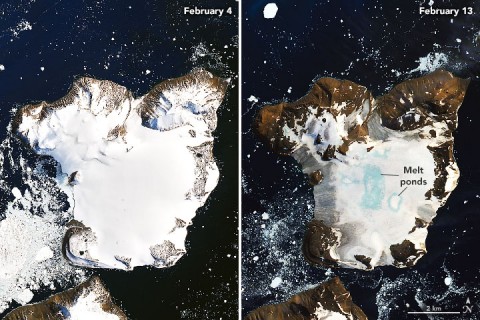
Image credit: NASA Earth Observatory
2020-02-25 Solar System
While Antarctica has become a tourist magnet for the wealthy causing increasing cruise ship and airplane traffic, on February 6th 2020, the temperature on the northern tip, Eagle Peninsula, climbed up to 18.3°C causing widespread melting on surrounding glaciers. Sea surface temperatures in the area were also higher than average by about 2-3°C. The mild temperatures lasted until February 13. Following warm spells in November 2019 and January 2020, these events are observed more frequently, which is significant and concerning.
: Further facts Link to source 🔗
Dimming Betelgeuse
Image credit: ESO / M. Montargés et al.
2020-02-18 Universe
About 700 light-years away, Betelgeuse is the primary but second brightest star in Orion. Although it is a known pulsating variable, its surface brightness distribution is less uniform than a year before, while its lower half is notably fainter. The dimming accelerated during the past five months by a factor of about 2.5 by February 2020. The dark area could be structures appearing as a result of native variability or ejected materials obstructing the surface, the latter being a pointer for the red giant star going nova in several thousands or hundred thousands of years. Prior to a nova explosion a star would brighten up for a while. Betelgeuse's explosion would shine as bright as the full moon. If placed at the center of our solar system, Betelgeuse would extend beyond the orbit of Mars, possibly to that of Jupiter's. Betelgeuse was the 7th brightest star in the sky, as of February 2002 it ranks 21th.
Earth-size Planet Detected
Image credit: NASA's Goddard Space Flight Center
2020-01-07 Exoplanets
Roughly 40% of the Sun's mass and size and about half its surface temperature, TOI 700 is a red dwarf hosting three known planets about 102 light-years away in Dorado. Although no stellar flares detected so far, the fast 37.42-days period of TOI 700 d, 1.22x Earths mass, suggests close proximity to the star. Strong radiation impact on planet d, which is probably tidally locked, may prohibit formation of life in spite of orbiting within the inner habitable zone. Several prediction models have been computed, but composition and atmosphere are still unknown.
Interstellar Comet
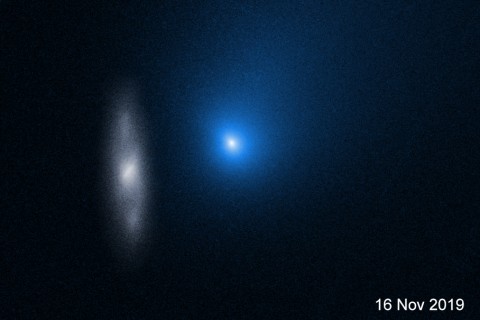
Image credit:
2019-12-14 Solar System
The comet 2I/Borisov, or C/2019 Q4 Borisov, is not one of the Solar System's and its origin is unknown. It made its closest approach to the Sun at just over 2 AU on 8 December 2019 while the closest approach to Earth at a distance of about 290 million kilometers occurred on December 28. Its core is estimated to be less than 1km across. Spectral analysis indicates that its composition appears to be similar to that of Solar System comets.
Jupiter's Europa
Image credit: NASA, JPL-Caltech, SETI Institute, Cynthia Phillips, Marty Valenti
2019-11-29 Solar System
A Galileo spacecraft image of Jupiter's moon Europa remastered with the latest calibration techniques. Shown in human-visible light, Europa is believed to harbor an ocean more than twice the size of Earth's under its ice layer, kept warm by tidal flexing, and possibly home to maritime life forms.
Interstellar Comet
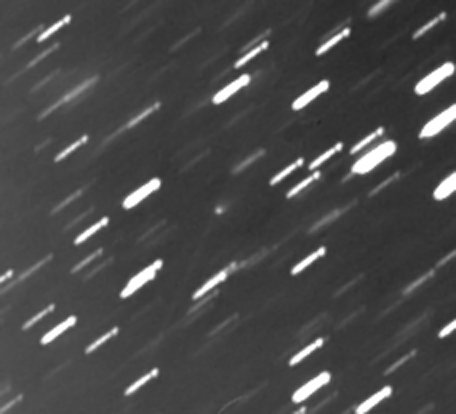
Image credit: Gennady Borisov with his 0.65-meter telescope.
2019-09-14 Solar System
Based on its current (hyperbolic) orbital elements interstellar comet C/2019 Q4 (Borisov) came from the constellation of Cassiopeia. Its reflectivity suggests a 10km wide nucleus that will get closest to the Sun at 2.04 AU in Crater on December 8, 2019 at a speed of 44km/s (nearly triple that of Voyager I and too fast for solar system body). It will be closest to Earth on Dec 28, 2019 at 1.9743AU when visible in southern Hydra. The comet should be observable for at least a year.
Water Vapor on K2-18 b
Image credit: Alex Boersma, www.alexboersma.com
2019-09-11 Exoplanets
Orbiting in 33 days around and inside its cool class M dwarf star's habitable zone at a distance of 124 light-years, planet K2-18 b, a Super-Earth, receives an energy amount that of Earth. Astronomers have spectroscopically detected water vapor in the thick gaseous envelope, assuming existence of liquid water clouds.
Planetary Imaging
Image credit: RWD
2019-09-09 Solar System
Although past their oppositions, both Jupiter and Saturn are visible in the early evening hours and still large enough for imaging details. Images captured with 150mm Newtonian, 2x barlow and ZWO ASI120MC-S.
Boulders of Bennu
Image credit: NASA/Goddard/University of Arizona
2019-05-24 Solar System
On March 28, 2019, NASA's OSIRIS-REx spacecraft captured this close-up image showing a view 50 meters wide of the rugged surface of asteroid Bennu from a distance of 3.4 km. Link to source 🔗
Juno's Jupiter Closeup
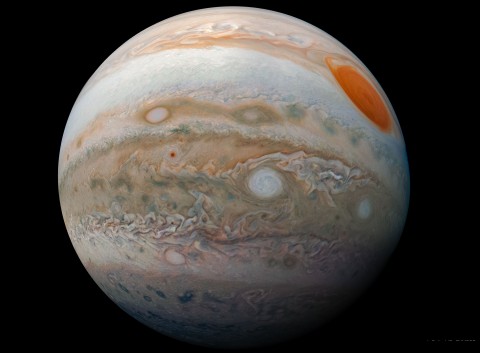
Image credit: NASA/JPL-Caltech/SwRI/MSSS/Kevin M. Gill
2019-05-08 Solar System
Juno took this composite image on Feb. 12, 2019, as the spacecraft performed its 17th science pass of Jupiter at a distance between 26,900 km and 95,400 km above Jupiter's cloud tops. Link to source 🔗
First Black Hole Imaged
Image credit: Event Horizon Telescope Cooperation
2019-04-11 Universe
Please imagine a tennis ball on the moon. Wide enough to fill it with the solar system, this is the first ever obtained image of the glowing dust and gas edges of a black hole. It is located in the center of the M87, a galaxy 54 million light-years away in Virgo. Also our galaxy, the Milky Way, centers a black hole though smaller.
Martian Solar Eclipses
Image credit: NASA/JPL-Caltech/MSSS
2019-04-05 Solar System
Solar eclipses were captured by NASA thanks to solar filters on Curiosity's Mastcam. Imaged when crossing the front of the Sun on March 26, 2019, Phobos is 11.5km across, while Deimos, 2.3km wide, crossed on March 17, 2019. Since both moons are small the eclipses are always annular, visually more like transiting, but cast a small sweeping shadow on the Martian surface while darkening the sunlight. Link to source 🔗
Planet GJ 685 b
Image credit: RWD
2019-03-30 Exoplanets
About 53 light-years away in Draco, the planet GJ 685 b with 9 Earth masses orbits at the hot edge of its host star's habitable zone. GJ 685, about half the size and mass of the sun, is the third and faintest star in the triple system 26 Draconis. The main pair AB completes an orbit every 76 years. The primary star is "sun-like".
Hydrated Minerals on Ryugu
Image credit: JAXA
2019-03-21 Solar System
Using a near-infrared spectrometer, the Hayabusa2 team has detected hydrated (water-containing) minerals on asteroid Ryugu.
A New Moon for Neptune
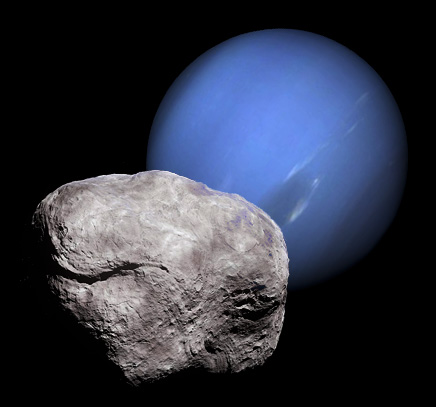
Image credit: Artist's Impression
2019-02-24 Solar System
Discovered in Feb 2019 in archival data from the Hubble Space Telescope of 2013, the latest know moon of Neptune was named Hippocamp (originally designated S/2004 N 1), is an about 35 km wide body. It appears to have been split from another moon, Proteus, after a collision. The orbits of the two moons are presently 12,000 km apart. Link to source 🔗
Sharpest View
Image credit: NASA/JHUAPL/SwRI/NOAO
2019-02-23 Solar System
To date the sharpest view of Ultima-Thule obtained 6.5 minutes before NASA's New Horizons' closest approach on January 1st from a distance of 6628km obtaining a resolution of about 33 meters per pixel.
Hayabusa2 Touched Down
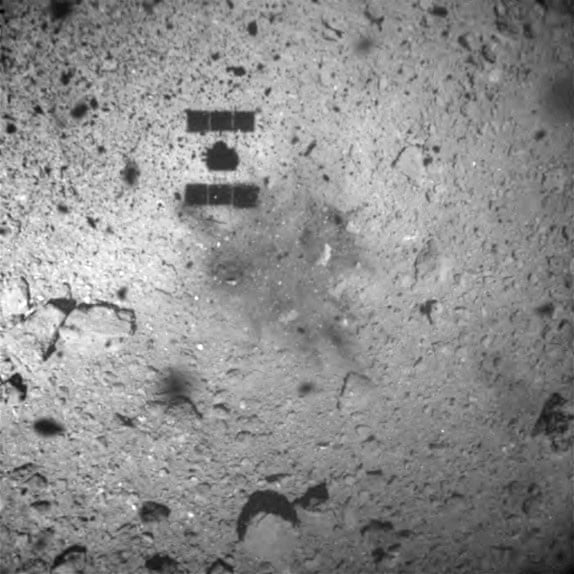
Image credit: Japan Aerospace Exploration Agency, JAXA
2019-02-22 Solar System
As a result of impressive team work, and with lessons learned from the previous mission, JAXA's Hayabusa2 touched down on asteroid Ryugu around 23:30 UTC, collected samples and returned back into space. The mission is scheduled to return to Earth with its samples in late 2020.
Saturn's Rotation Period
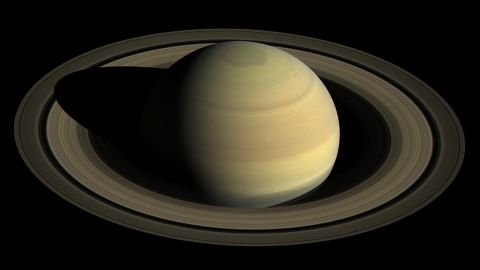
Image credit: NASA/JPL-Caltech/Space Science Institute
2019-01-19 Solar System
Saturn has an unusual magnetic field, no solid surface hence no landmarks to measure its axial rotation period. Cassini scientists found the key in the rings and determined the period is 10:33:38, or 0.4400231 days. Link to source 🔗
Rings of Jupiter
Image credit: NASA/JPL-Caltech/SwRI
2019-01-19 Solar System
On July 16, 2018, NASA's Jupiter explorer spacecraft Juno captured an image of Jupiter's ring, half in Jupiter's shadow, from a unique high northern latitude of 55°, as Juno flew inside the ring. Link to source 🔗
Quadrantids' Fireball
Image credit: Masayoshi Ueda, Osaka
2019-01-04 Solar System
The first fireball in 2019 lit up the sky in western Japan on Thursday night. January 3rd/4th are amid the Quadrantids meteor shower, its peak lasting only a few hours with an average of 120 strikes per hour. The Quadrantids are known for fireballs, typically some 10cm across.
China Lands Craft on the Moon
Image credit: China National Space Administration
2019-01-04 Solar System
China's spacecraft Chang'e 4 landed on January 3, 2019 at 2:26 UTC in the 186km wide Van Karman crater, South Pole-Aitken Basin (farside of the moon), and deployed a rover with six wheels and two solar panels. A relay satellite links the control center with the farside. A remarkable achievement of Chinese scientists.
New Horizons' Successful Flyby
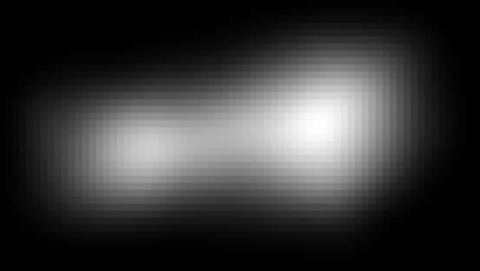
Image credit: NASA/JHUAPL/SwRI
2019-01-02 Solar System
What an incredible achievement, NASA and cooperators! New Horizons' systems show all green. The first images are gradually checking in coming in from over 6.4 billion km out there. Image date is 31 December 2018.
Asteroid (163899) 2003 SD220

Image credit: NASA/JPL-Caltech/GSSR/NSF/GBO
2018-12-22 Solar System
A radar image of asteroid (163899) 2003 SD220 with unprecedented detail comparable to that of a flyby shot. The asteroid is 1.6km long with a slow axial spin period of nearly 12 days. Link to source 🔗
Ice-Filled Martian Crater

Image credit: ESA/DLR/FU Berlin
2018-12-21 Solar System
ESA's Mars Express image of Martian crater Korolev, located near the north polar cap, shows a 1.8km deep and 60km wide pool of permanent water ice. Link to source 🔗
Water on Asteroid Bennu
Image credit: NASA/Goddard/University of Arizona
2018-12-11 Solar System
Merely a week after arriving, NASA’s OSIRIS-REx spacecraft has detected water containing clay minerals on asteroid Bennu. Image taken on Dec 2, 2018. Link to source 🔗
Sound from InSight
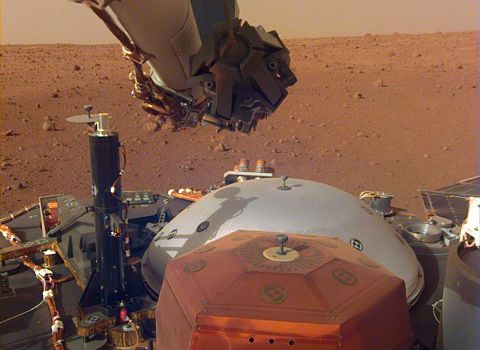
Image credit: NASA/JPL-Caltech
2018-12-09 Solar System
Audio data from the seismometer on NASA's InSight spacecraft of vibrations caused by Martian wind.
Link to source 🔗
InSight Has Landed
Image credit: NASA/JPL-Caltech
2018-11-27 Solar System
Congrats on another success. NASA's InSight Mars lander touched down in one piece in Mars' Elysium Planitia region on Nov 26, 2018 and returned a photo.
Bennu at 136km
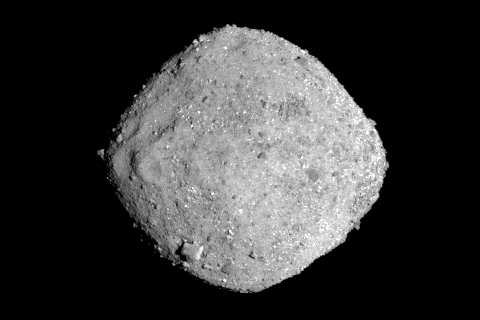
Image credit: NASA/Goddard/University of Arizona
2018-11-24 Solar System
Bennu on November 16, 2018, from a distance of 85 miles (136 km). The image, which was taken by OSIRIS REx's PolyCam camera, shows Bennu at 300 pixels.
Second Nearest Exoplanet?
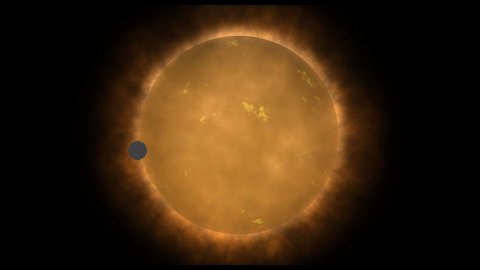
Image credit: Public domain illustration, RWD
2018-11-15 Exoplanets
Red dwarf "Barnard's Star" is the second closest star to our Sun (5.958 ly). It possibly hosts a planet with min. 3.23 Earth masses orbiting in 232.8 days at 0.404AU, the outer edge of the habitable zone. Stay tuned.
Sharp View of Bennu
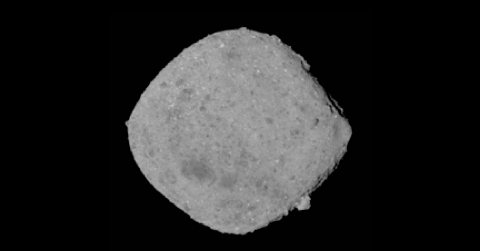
Image credit: NASA/Goddard/University of Arizona
2018-11-10 Solar System
This view of asteroid Bennu was obtained by OSIRIS-REx on Nov 2, 2018 from a distance 122 miles (197 km) from the spacecraft. Bennu rotates once in 4 hours and 11 minutes. The north pole is at the top of the image. Link to source 🔗
Kepler Retired
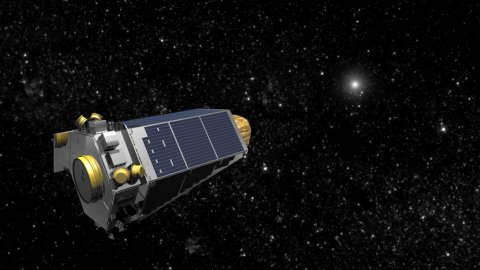
Image credit: NASA
2018-10-31 Exoplanets
Running out of fuel, NASA has decided to decommission its Kepler Space Telescope after nine years of unveiling over 2600 confirmed planets since 2009.
Probably First Exomoon
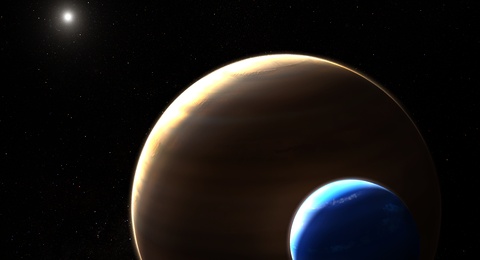
Image credit: NASA, ESA, and L. Hustak (STScI)
2018-10-04 Exoplanets
The first exomoon is believed to exist around a large Jovian planet orbiting Kepler-1625, some 5300ly away in Cygnus. The mass ratio is similar for the Earth-moon system, but 11 times boosted in scale.
Ryugu Surface Closeup
Image credit: JAXA, University of Tokyo, Kochi University, Rikkyo University, Nagoya University, Chiba Institute of Technology, Meiji University, Aizu University, AIST).
2018-09-28 Solar System
When Hayabusa2 descended towards Ryugu to deploy MINERVA-II1 on September 21, 2018 at around 14:04 UTC, its ONC-T camera captured the surface of Ryugu from an altitude of 64 meters, the highest resolution image obtained to date. The sun shines from the left casting the shadow of a large boulder. 🔎Show Position
Minerva has Landed
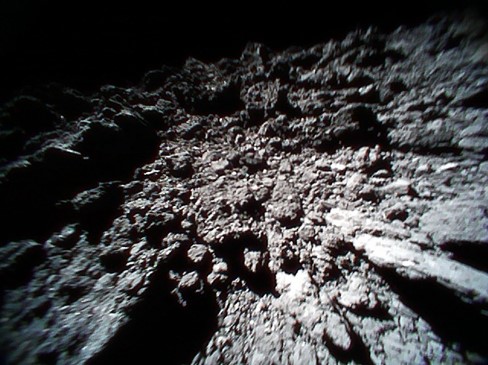
Image credit: JAXA
2018-09-27 Solar System
On September 21, the two MINERVA-II1 rovers, Rover-1A and Rover-1B separated from Hayabusa2. Image of Ryugu's surface taken on September 23, 2018 at 01:10 UTC taken by MINERVA-II1's Rover-1B after landing.
Water Ice at Lunar Poles
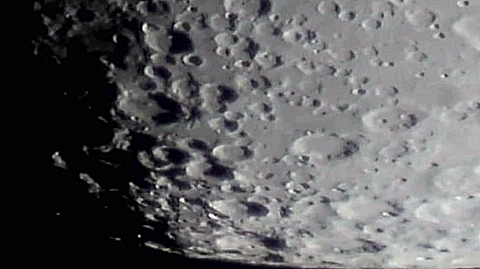
Image credit: Requio Web Design
2018-08-21 Solar System
The M3 instrument aboard the Indian Chandrayaan-1 spacecraft directly observed definitive evidence of water ice at the lunar poles. Most of the water ice concentrates in the eternal shadows of craters at the south pole while widely, but sparsely spread, at the north pole.
Hayabusa2 Arrived
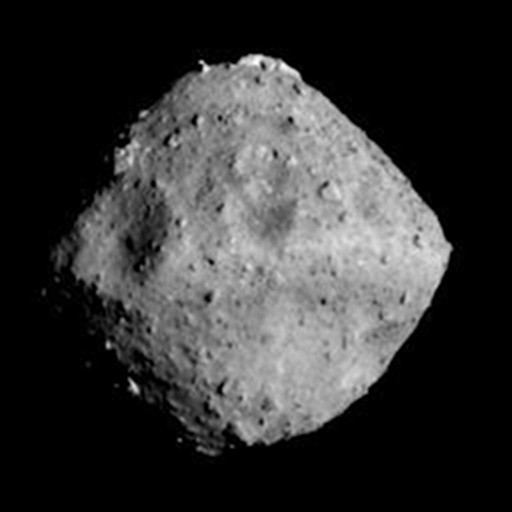
Image credit: JAXA, University of Tokyo, Kochi University, Rikkyo University, Nagoya University, Chiba Institute of Technology, Meiji University, Aizu University, AIST
2018-06-27 Spaceflight
On June 27, 2018 JAXA's Hayabusa2 spacecraft arrived at the 900 meters wide asteroid Ryugu. Photo taken from a distance of around 40km on June 23 UTC.
Subsurface Ice on the Moon
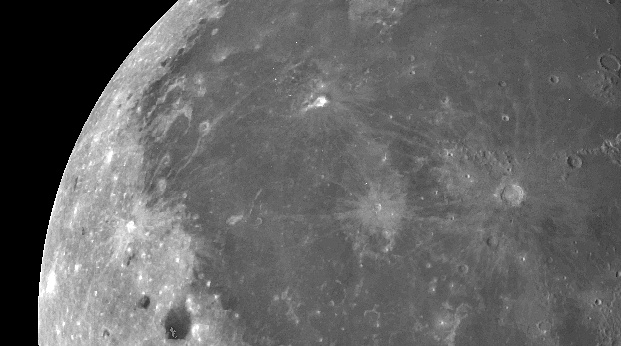
Image credit: Public Domain
2018-05-16 Solar System
A Japanese research team said that abundant water is highly likely to exist in the form of ice under Oceanus Procellarum.
Nickname for KBO 2014 MU69

Image credit: NASA/JHUAPL/SwRI/Steve Gribben
2018-03-15 Solar System
To be visited next by New Horizons, the KBO cataloged as "2014 MU69" has been nicknamed "Ultima Thule". NASA narrowed its selection to near the top of 29 publicly nominated names. Link to source 🔗
Flare from Proxima Observed
Image credit: NASA/ESA/G. Bacon (STScI)
2018-03-02 Exoplanets
Analysis of ALMA observations reveal a significant flaring event on March 24, 2017 which lasted for about one minute as Proxima Centauri brightened up for 10 seconds by a factor of 1000 compared to the star's quiescent emission. Absence of excess emission rules out a dust belt in 1 to 4AU distance which was previously assumed. Proxima has one known planet orbiting at a distance of a mere 0.0485 AU (20 times closer than the Earth orbits the Sun) in that this powerful flare may question habitability of the nearest known exoplanet, because a flare 10 times larger than a major solar flare would blast Proxima's planet with 4,000 times more radiation than the Earth gets from our Sun’s flares. Link to source 🔗




